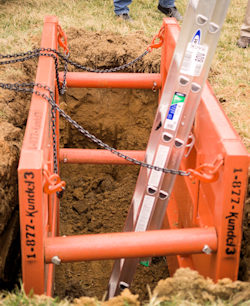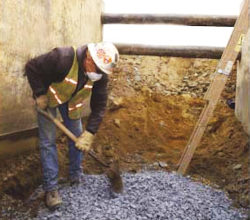Shielding Systems
In this method, a trench box or shield designed or approved by a registered professional engineer is used. Timber, aluminum, or other suitable material may be used in the construction. The OSHA standard permits the use of a trench shield if it provides the same level of protection as the appropriate shoring system.
Employers can choose the most practical method for the particular circumstance, but that system must meet the required performance criteria. The standard doesn't require a protective system when an excavation is made entirely in stable rock or is less than five feet deep. However, in this case, a competent person must examine the ground and find no indication of a potential cave-in.
When installing a trench shield, the contractor should excavate a wider area than the necessary minimum. This provides a more comfortable working environment for your employees in the trench.
This extra working area may provide a way for workers to escape an unexpected crisis, such as falling objects or debris. Contractors should also reduce risk by limiting the number of workers in the trench. The only workers allowed in the trench should be those who are absolutely needed to perform the task at hand.
As the trench is backfilled, the braces and planks can be removed to be used at another site. If installed and removed correctly, vertical planks and trench braces may be used several times!
1926.652(g) Shield systems-
- (1) General.
- (i) Shield systems shall not be subjected to loads exceeding those which the system was designed to withstand.
- (ii) Shields shall be installed in a manner to restrict lateral or other hazardous movement of the shield in the event of the application of sudden lateral loads.
- (iii) Employees shall be protected from the hazard of cave-ins when entering or exiting the areas protected by shields.
- (iv) Employees shall not be allowed in shields when shields are being installed, removed, or moved vertically.
- (2) Additional requirement for shield systems used in trench excavations. Excavations of earth material to a level not greater than 2 feet (.61 m) below the bottom of a shield shall be permitted, but only if the shield is designed to resist the forces calculated for the full depth of the trench, and there are no indications while the trench is open of a possible loss of soil from behind or below the bottom of the shield.
See Appendix B on OSHA's website for detailed slope configurations. (External link)
Knowledge Check Choose the best answer for the question.
4-6. The OSHA standard doesn't require a protective system when an excavation is _____.
You forgot to answer the question!


